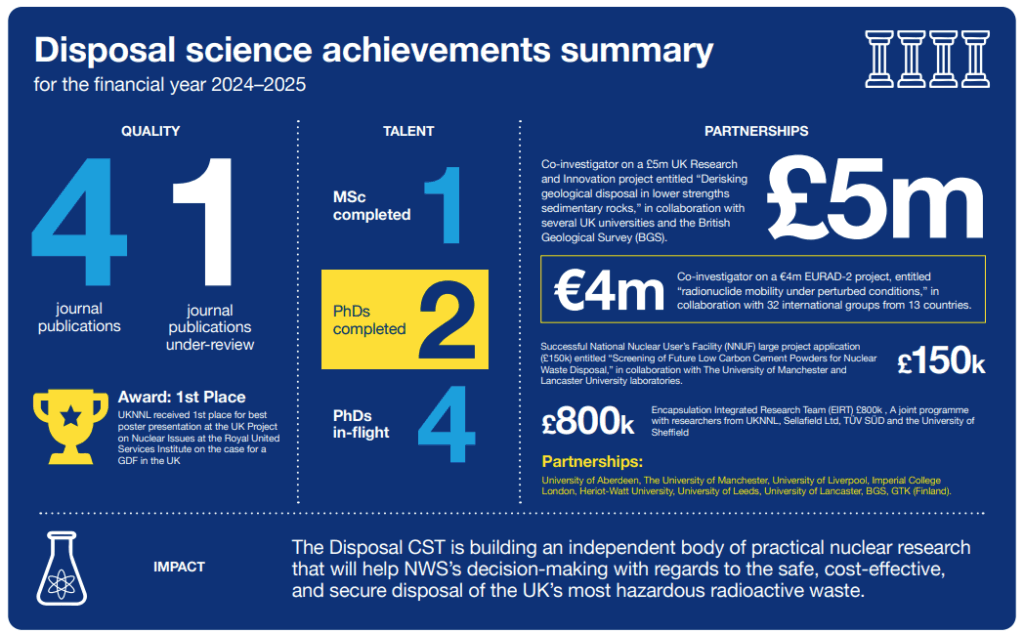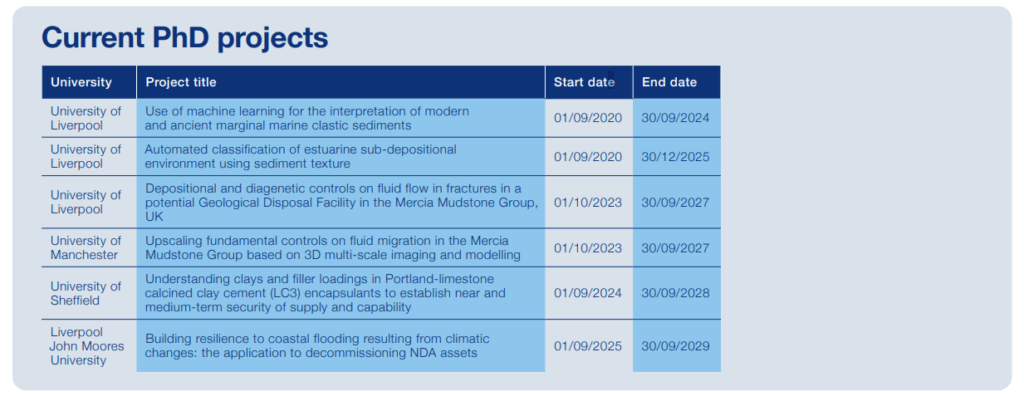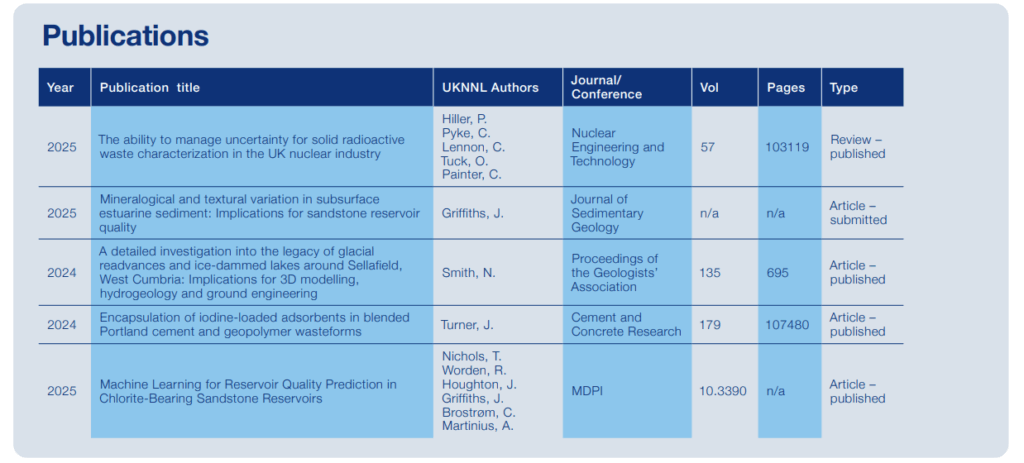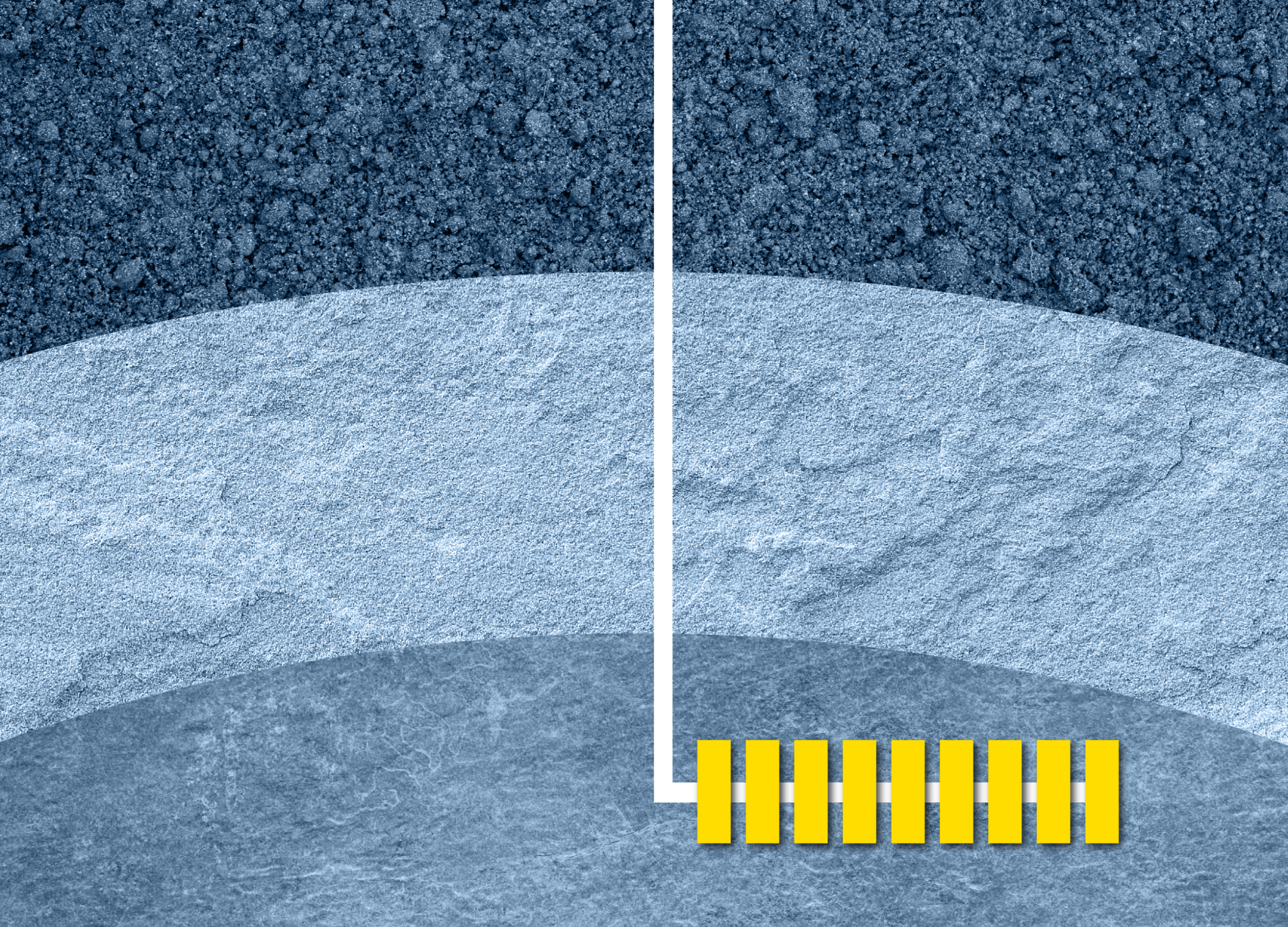Safe and secure long-term disposal of the UK’s nuclear waste is a national priority. Research by UKNNL’s teams is providing insight to support the location and design of future radioactive waste disposal deep underground. At the same time, these projects are nurturing nuclear skills in the future workforce and scientific community through collaborations with universities across the UK and by funding research projects aligned to this critical national mission.
Two major projects are underway. The UK Research and Innovation GeoSafe project is investigating the geology of potential locations for a geological disposal facility (GDF). The National Nuclear User Facility project is assessing low carbon cement formulations for waste encapsulation – critical to containing and storing nuclear waste.
This case study gives more detail about both projects and the concept of a geological disposal facility, linked to the UK’s nuclear power generation heritage.
Leveraging expertise and building UK capability to support national priorities
It is a critical national mission to develop an understanding of how and where nuclear waste can be disposed in the long term. The current plan is for it to be permanently disposed of in a GDF to ensure that the waste is isolated and passively contained away from human intrusion.
As the UK government’s lead civil nuclear fission laboratory with a wealth of experience across the nuclear fuel cycle and world-class facilities, UKNNL launched a disposal research theme in recognition of this nationally significant infrastructure project.
Aligned to UKNNL’s recent strategic review, the disposal theme will help play a fundamental role in accelerating the UK to net zero, by delivering cutting-edge innovation and demonstrating new nuclear technologies.
The process of siting, designing and constructing a GDF is one of the UK’s largest environmental protection programmes.
In support of the GDF mission led by Nuclear Waste Services (NWS), UKNNL’s research will focus on the interaction between waste forms, engineered barrier systems and potential host rock environments.
Research teams collaborate across UKNNL to investigate a range of radioactive waste management and disposal topics. They also collaborate with universities, the supply chain and other critical public sector research establishments, such as the British Geological Survey.
A key output of the disposal theme is bolstering future skills within the UK to aid in developing capacity and capability within the UK where there will likely be increased future demand because of the long-term requirements of the UK GDF programme.
To achieve this, the disposal theme is working with the Nuclear Decommissioning Authority (NDA), NWS and the Department for Energy Security and Net Zero to nurture early career development. The programme will foster new skills through impactful science and engineering aligned to delivering national priorities.
NuClear Science in depth: Future-proofing disposal
We can expect significant environmental and societal change over the lifetime of a GDF. The UK landmass may experience renewed glacial periods or even new civilisations after GDF closure and therefore it must be able to withstand such changes. To achieve this, a GDF is comprised of several natural and engineered barriers which provide defence in depth; this is known as the multi-barrier concept.
Waste which has been mixed with cement (grouted) or turned into glass (vitrified) is packaged in a metal container. This is placed underground, surrounded by a buffer of breathable materials which allow potential gas to escape to avoid overpressure (e.g., from the corrosion of steel or radiolysis of water).
The underground disposal location needs to be a natural low-permeability rock, known as a host rock, with little to no groundwater movement to isolate the wasteforms and remove the potential for naturally occurring radionuclide transport pathways.
There’s plenty of evidence about the long-term efficacy of the types of materials that may be used in a UK geological disposal facility. The pristine preservation of ancient glass and ceramics uncovered by archaeologists, and oil and gas trapped in rock for tens of millions of years show us what is possible. Understanding these processes gives confidence on how engineered and natural systems could operate in unison to isolate waste for hundreds of thousands of years.
To be successful, it’s critical that all aspects of the multi-barrier concept work together. For example, if groundwaters are salty then the appropriate materials for the GDF design must be selected to withstand this kind of harsh environment.
Pioneering Nuclear means managing legacy waste
As a pioneer of nuclear technology, the UK has been producing and managing radioactive waste on an industrial scale since the 1940s. Currently, the UK’s most hazardous radioactive waste is stored in ageing nuclear fuel storage ponds and waste silos which were not designed to store waste indefinitely.
How the UK Government, led by the NDA, chooses to manage and dispose of this inventory has sparked debate within scientific, political and societal spheres. Key challenges include safety, environmental impact, security (including nuclear proliferation), cost, deliverability and a shortage of both technical and non-technical critical skills.
Aligned to international best practice, the UK Government’s plan is to immobilise and dispose higher activity radioactive waste without further human intervention (known as passive containment). It will be contained in a GDF between 200 metres and 1000 metres deep underground for hundreds of thousands of years.
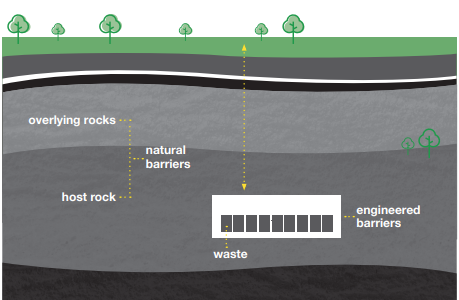
Geosphere characterisation and evolution: GeoSafe project
UKNNL is currently participating in research projects to aid in characterising two end-member UK mudstone units that may act as future host rocks for a UK GDF.
The Jurassic Ancholme Group mudstones, found in the deep geology off the coast of Lincolnshire, are relatively well understood and similar to potential European GDF host-rocks like those in France, Switzerland and Belgium. By contrast, the Triassic Mercia Mudstone Group, found in the deep geology off the coast of west Cumbria, is more complex as it also contains a wider range of potential rock types, such as mudstones along with rocks formed by the evaporation of saline solutions, known as evaporitic rocks.
Importantly, both potential host rocks have a history as caprocks to multiple oil and gas fields, meaning we know they have the capacity, under the right conditions, to hold back fluid for hundreds of millions of years – longer than required for a GDF.
However, more robust understanding is required to ensure the potential GDF host rocks are feasible. As part of the GeoSafe consortium led by Imperial College London, UKNNL will undertake fundamental research that will advance NWS’s understanding of the potential effects of a GDF on potential host rock environments. Research outputs will be integrated to help inform the siting process and design of the GDF.
Specifically, UKNNL’s teams are conducting research related to subsurface characterisation and coupled-process reactive transport modelling to better understand how contaminants may move through the host rock and engineered barrier environments over GDF timescales.
In addition, as part of our commitment to champion and nurture advanced nuclear skills, and as custodian of national capabilities, UKNNL is also investing in several PhD projects that will further bolster the GeoSafe team.
“Working with UKNNL during my PhD project is incredibly
beneficial for both my personal and professional development. My UKNNL supervisors have vast knowledge and experience with characterising and modelling properties of key rock units in the UK, which helps guide my project into very interesting research avenues and their support and guidance is invaluable to me.”
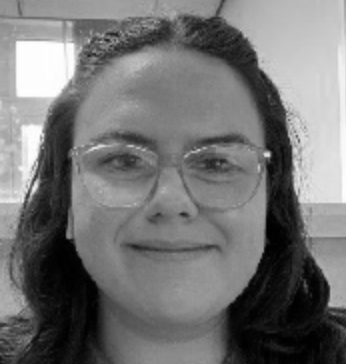
Holly Mills
PhD student (UKNNL-funded) The University of Manchester
The research in detail
In the geological containment part of the GeoSafe project, UKNNL is carrying out novel research, as well as funding additional PhD research at The University of Liverpool and The University of Manchester, to better understand how small to large-scale (sub-mm to several km) variability in the Mercia Mudstone Group may impact its ability to isolate fluid and contaminants. Research includes studying rock outcrops across the UK, studying legacy boreholes, and building geological models as inputs to reactive transport models.
The contaminant pathways part of the GeoSafe project will see UKNNL leverage its world-class radiochemistry and geochemistry expertise (built up in partnership with the Environmental Radiochemistry research theme under our Core Science programme), to build a mechanistic understanding of how radionuclides and non-radioactive contaminants may migrate within lower strength sedimentary rocks (LSSR) over hundreds of thousands of years.
UKNNL is working alongside Heriot-Watt University to investigate the interactions between chemical reactions, fluid flow and mass transport phenomena like advection, diffusion and dispersion in the mathematical modelling part of the GeoSafe project. The ambition of this work programme is to improve our understanding of how these complex interactions influence the behaviour of the fluids and solutes.
“Collaborating with UKNNL on waste disposal has been an immensely rewarding experience, broadening my perspective on research areas and challenges and helping with my career development. Throughout the projects we have worked on together, I’ve gained valuable insights into many waste management techniques and a comprehensive understanding of the complex issues faced by the nuclear industry, along with the critical scientific questions we aim to resolve. I am grateful that my expertise can contribute to advancing solutions in the nuclear sector, and I look forward to a continued partnership that fosters further growth and discovery.”

Dr Lin Ma
Senior Lecturer The University of Manchester
Future of encapsulants and engineered barrier systems: NNUF project
The UK nuclear industry, until recently, has relied on bespoke carbon-intensive cements for some waste forms. The industry is evolving rapidly to use lower carbon variants, both to encapsulate waste and as part of the GDF.
Hypersaline groundwater conditions may also be present within the Mercia Mudstone Group, creating a chemically aggressive environment for cement-based materials.
In partnership with The University of Manchester and Lancaster University, UKNNL is working on two projects funded by the National Nuclear User Facility (NNUF):
- Encapsulation of uranium metal in traditional and lower-carbon cement formulations: these experiments will investigate the corrosion of uranium metal, using advanced three-dimensional imaging to look at the interaction between the uranium and different low-carbon cements over time.
- The effect of different groundwaters to understand the interaction with different cements: low-carbon and traditional cement forms will be exposed to three groundwater compositions (high salinity, high sulphate and high carbonate). This will assess the viability of low-carbon cements and advance knowledge of how different cements work as encapsulants as part of the wider engineered barrier system.
Impact
UKNNL is building an independent body of practical nuclear research that will help NWS’s decision-making about which location(s) are suitable for GDF and the design of the facilities.
The results of this research will help ensure potential host rocks can provide a safe, secure and permanent home for the UK’s most hazardous nuclear waste, and low-carbon technologies can be used when viable to reduce the sector’s carbon footprint.
The collaborations and commitment from this work will grow the next generation of technical experts through investing in people in their early careers, as well as at undergraduate and postgraduate level. This will ensure today’s decisions can be safely and securely implemented by future experts.
“The UKNNL Disposal Core Science Theme team contribute to a range of NWS projects across several topic areas. These include PhD programmes aimed at developing geological understanding of materials across a range of scales, and other projects aimed at developing tools and techniques to understand groundwater geo-chemistry processes. This work has contributed to Nuclear Waste Services’ knowledge base on material properties relevant to a UK Geological Disposal Facility.”
Andy Wiseall
Senior Geological Operations Manager Nuclear Waste Services
